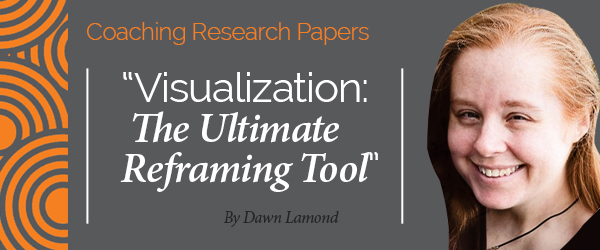Research Paper By Dawn Lamond
(Transformational Coaching, UNITED STATES)
What is Visualization?
Visualization is not, despite what the name suggestions, necessarily visual. It takes place when senses of any kind – including emotions – are used to fabricate a potential reality for experiential learning and awareness.
It does not require any special technique or a quiet space or a great deal of time or special training on the part of the facilitator or any kind of special set up – though it can.
Visualization, then, is the purposeful use of the imagination to project one’s self into a particular space for the purpose of exploration, learning and discovery. This can be done through a facilitator (a coach), or by one’s self with equal effectiveness.
Many studies have been conducted proving the efficacy of visualization to the point that it’s practically become a household word, usually in relationship to sports.
Its use is extremely applicable for coaches, as well. Take for instance this quote from an article in Psychology Today[1] –
Brain studies now reveal that thoughts produce the same mental instructions as actions. Mental imagery impacts many cognitive processes in the brain: motor control, attention, perception, planning, and memory. So the brain is getting trained for actual performance during visualization. It’s been found that mental practices can enhance motivation, increase confidence and self-efficacy, improve motor performance, prime your brain for success, and increase states of flow – all relevant to achieving your best life!
How Can You Use Visualization as a Coach?
I have referred to Visualization as the ultimate reframing tool because it can literally throw out the frame and put everything into an entirely new perspective, all through using the imagination.
Visualization can be used in any situation that could use a fresh look, as long as the coach has the client’s interest and permission. It requires a moment of time set aside with the intention of using the imagination to create a new way of experiencing something.
It can be used to create a comfortable space in which coaching can take place
Some examples:
For example, I often begin with new clients by asking them if they’d like to create a special coaching space with me to be used just for our sessions.
I’ll then ask them where they’d like to be, if they could be anywhere. Many have chosen beaches, mountains, forests. I ask them if they’re sitting or standing. If there are smells or a breeze. They’ll typically begin providing their own details, like the sun or beach sand for instance.
Toward the end, I’ll let them know where I am, in their space. Then, each subsequent session, we’ll begin our call by entering and re-experiencing that space again. This practice builds rapport very quickly, and helps establish a constant that clients can enjoy every time.
It can be used to allow a client to experience something that has yet to happen
Some examples:
In other words, visualization need not be just used for rehearsal and practice – it can be used to create potentials in the client’s mind, that can then be allowed to play out in a safe environment.
The power of this technique is not to be underestimated.
To take from a real life coach/client example, I once was working with a woman who wanted to begin dating, yet had been unsuccessful in her attempts so far.
With her permission, I asked her to imagine standing in a room. Once she was used to this idea, I said that she now saw, coming in from a door opposite her, the perfect partner for her first date.
She immediately became tense and uncomfortable and we paused so I could ask her about those feelings, and what she felt they meant. She came to realize that she didn’t want her perfect partner to see her then. That she felt she wasn’t perfect enough.
As you can imagine, this led to a very rich area for us to delve in to.
